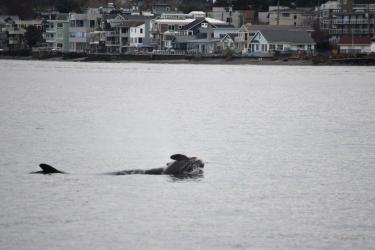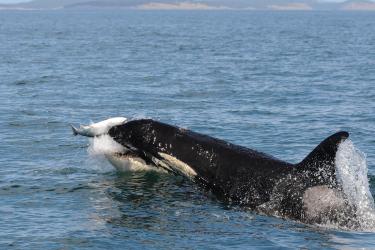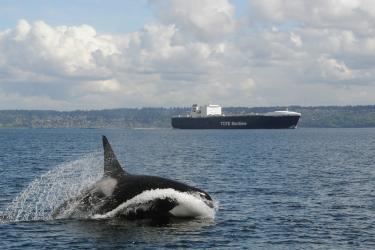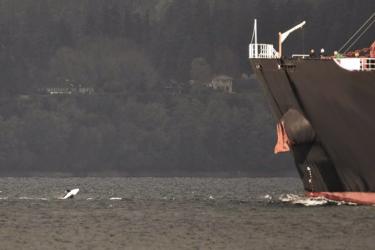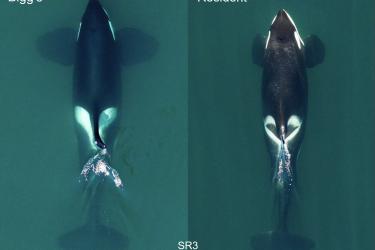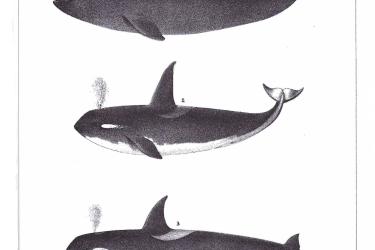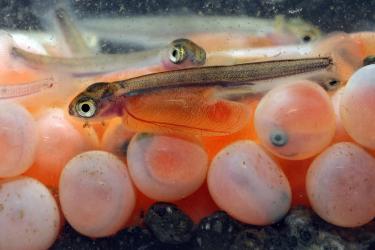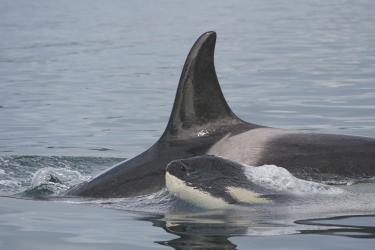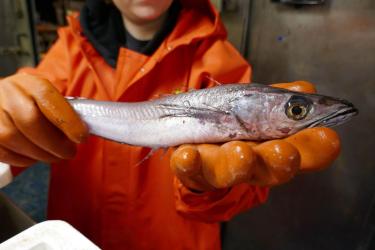Southern Resident Connections
Southern Resident killer whales are icons of a vibrant but struggling marine ecosystem. Join us in exploring the ecological connections that tie this system together, and the ways we are protecting and working to recover the whales we care so much about.

This series highlights the threads connecting Southern Residents' health, well-being, and chances for successful recovery. Southern Residents are connected to other species in the ecosystem, such as salmon; components of the ecosystem, including terrestrial and aquatic habitats; and all of us—our everyday choices for recreation, yard care, transportation, and many other actions have profound impacts on the species and the ecosystems.
You'll hear from scientists, recovery managers, fish biologists, and others who are working to understand and address the risks to the whales. Some of the efforts they will highlight will be familiar, and others are emerging. We will explain both the challenges we face and the progress we are making.
Southern Resident Killer Whale Calf Dies Days after Birth; Second Newborn Appears Healthy
J35 (aka Tahlequah), who made an impression around the world in 2018 for carrying her dead calf for 17 days, is again carrying a newly dead newborn calf.
Learn more about the serious challenges facing the Southern Resident killer whales.
Comparing Killer Whale Cuisine
New research aims to understand how two populations of North Pacific resident killer whales find food and what they eat.
Learn more about how scientists studied two populations of fish-eating killer whales.
Why Can’t Killer Whales Find and Capture Food? The Ocean Is Too Noisy
New research shows that vessel noise—the rumble and churn of boats and ships—disrupts killer whales' ability to find and capture food.
Learn more about how vessel noise reduces foraging efficiency and success.
Quiet Sound’s Voluntary Ship Slowdown Reduces Underwater Noise Reaching Killer Whales
The arrival of endangered Southern Resident killer whales in Admiralty Inlet and Puget Sound in September will trigger a voluntary slowdown for large commercial vessels.ast year, the slowdown reduced by half the underwater noise reaching the whales.
Learn more about the voluntary slowdown of large ships in Puget Sound.
New Research Reveals Full Diversity of Killer Whales as Two Species Come into View on Pacific Coast
Scientists have resolved one of the outstanding questions about one of the world’s most recognizable creatures, identifying two well-known killer whales in the North Pacific Ocean as separate species.
Learn more about worldwide killer whale species diversity.
Lost Skulls and Latin: How Scientists Chose Names for Newly Identified Killer Whale Species
California whaler Charles Melville Scammon first described the killer whales of the West Coast, and documented his observations and findings in a manuscript he sent to the Smithsonian Institution.
Hatcheries Yield More Salmon for Endangered Killer Whales; New Analysis Open for Comment
Additional federal funds for Northwest salmon hatcheries have helped increase adult salmon available to endangered Southern Resident killer whales
Learn more about an analysis of methods to help the Southern Resident killer whale population.
Persistent Pollutants from Mother’s Milk Turn Dolphin Calves More Toxic Than Mom
When bottlenose dolphins nurse their young, they transfer toxic pollutants such as polychlorinated biphenyls (PCBs) and DDT to their calves through their milk. New research shows that the calves end up with higher concentrations of the toxins than their mothers.
Learn more about raised concerns for killer whales that are closely related.
Estimating the Age of Endangered Southern Resident Killer Whales Using an Epigenetic Clock
Scientists have discovered a new way to estimate the age of endangered Southern Resident killer whales by analyzing DNA from their skin.
Learn more about new molecular technique to help us understand killer whales
Inbreeding Contributes to Decline of Endangered Killer Whales
The small size and isolation of the endangered population of Southern Resident killer whales in the Pacific Northwest have led to high levels of inbreeding. This inbreeding has contributed to their decline, which has continued as surrounding killer whale populations expand, according to research published in Nature Ecology and Evolution.
Learn more about new genome sequencing.
Southern Residents Work Harder For Prey, But Catch Fewer Fish, New Research Finds
Resident killer whales such as the Southern Residents set themselves apart from other killer whales by behavior more than appearance. They prey on salmon rather than marine mammals, travel and forage in larger groups, and follow the leadership of older females in family group.
Learn more about how researchers compared foraging of two resident killer whale populations.
Sharper Picture of Salmon in the Ocean Resets Threshold for Fishing Limits
New research examines how Chinook salmon from West Coast rivers travel through the ocean. It shows that endangered Southern Resident killer whales do not have access to as many salmon prey as previously thought. That does not mean the number dropped, but that it has always been lower than estimated.
Coordinated Response Protected Southern Residents From Sunken Ship Leaking Oil
What do you do when endangered Southern Resident killer whales are headed toward an oil spill?
That was the question NOAA Fisheries, along with federal, state, and local partners, wrestled with this summer. Endangered killer whales were spotted in the Strait of Juan de Fuca headed toward the San Juan Islands, where a fishing vessel had gone down and was leaking fuel. After determining that the crew was safe, the oil spill response team focused on protecting the environment, the iconic Southern Resident killer whales, and other precious resources.
NOAA Fisheries and partners diverted endangered whales from potential harm. Learn more
